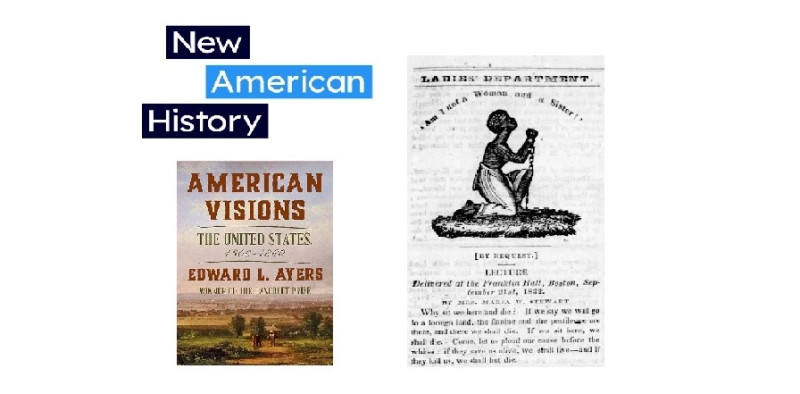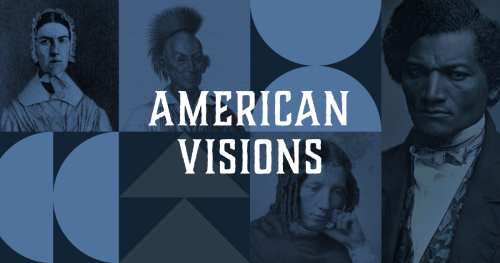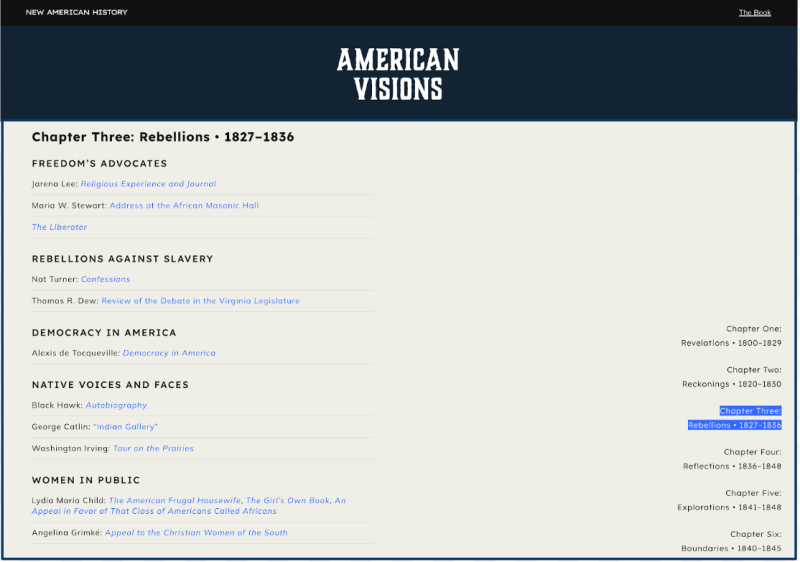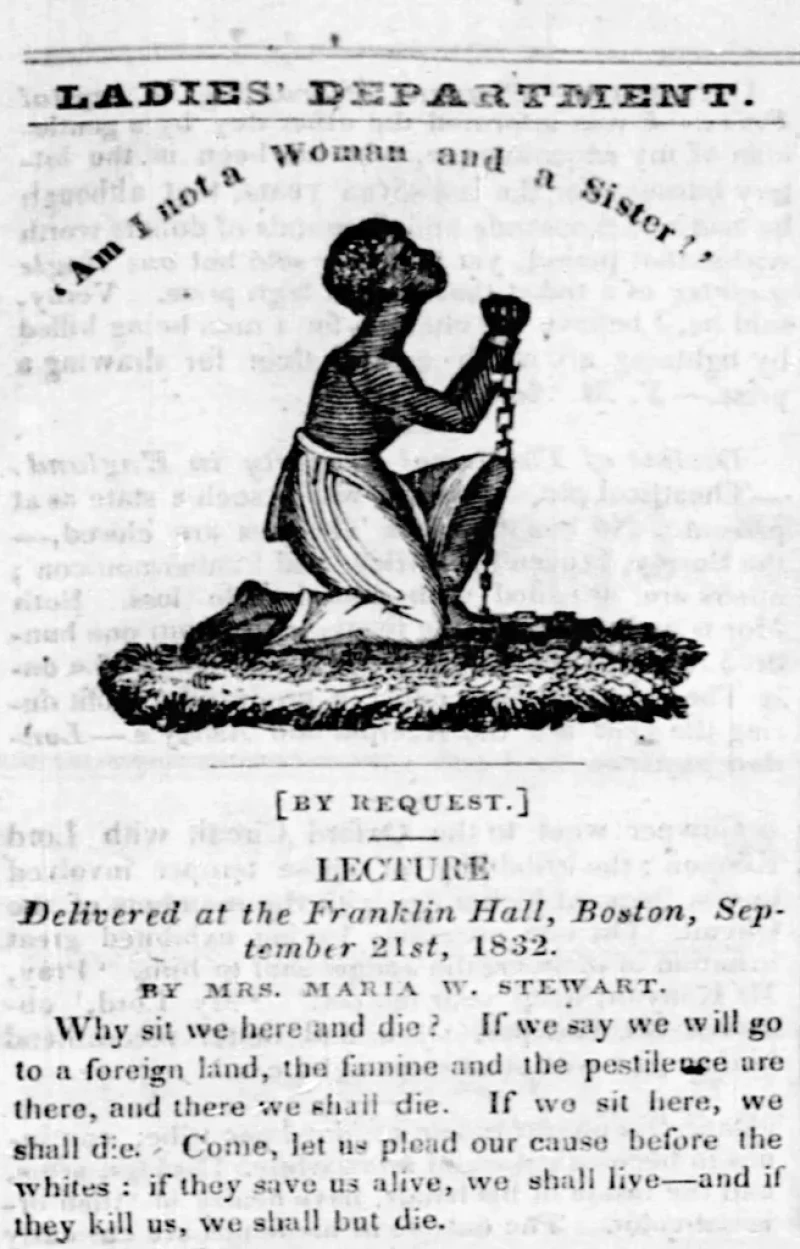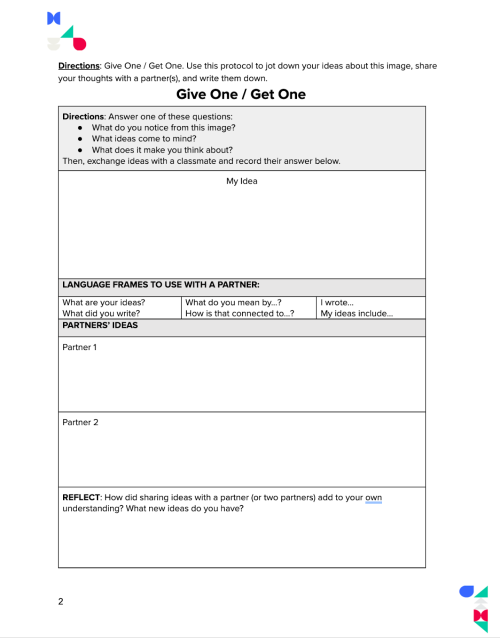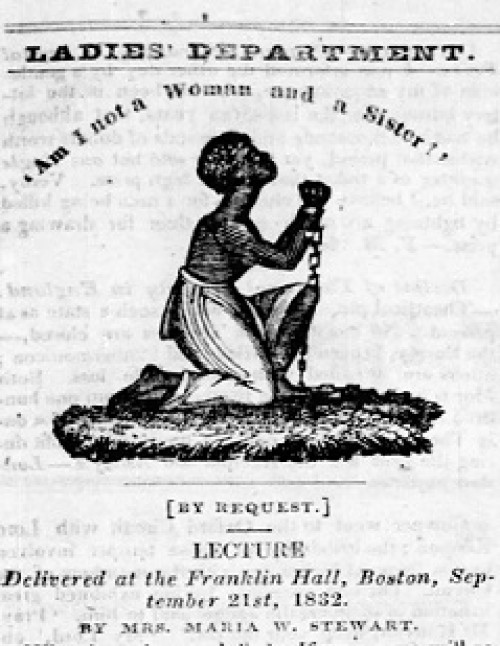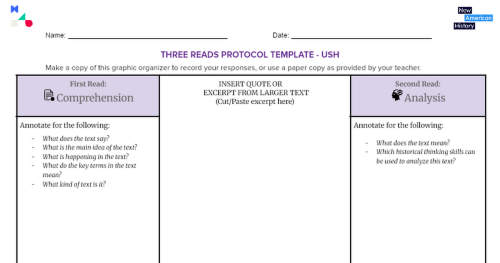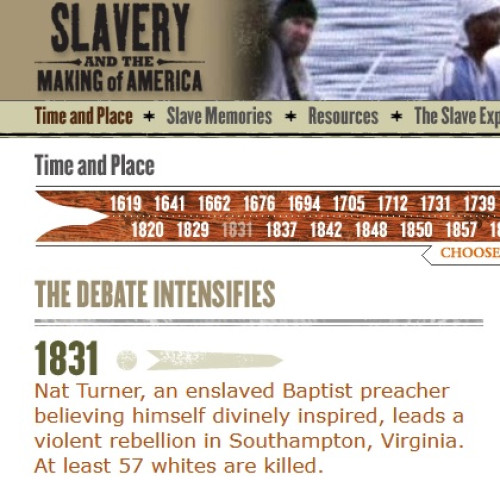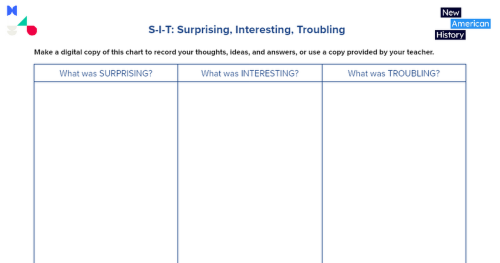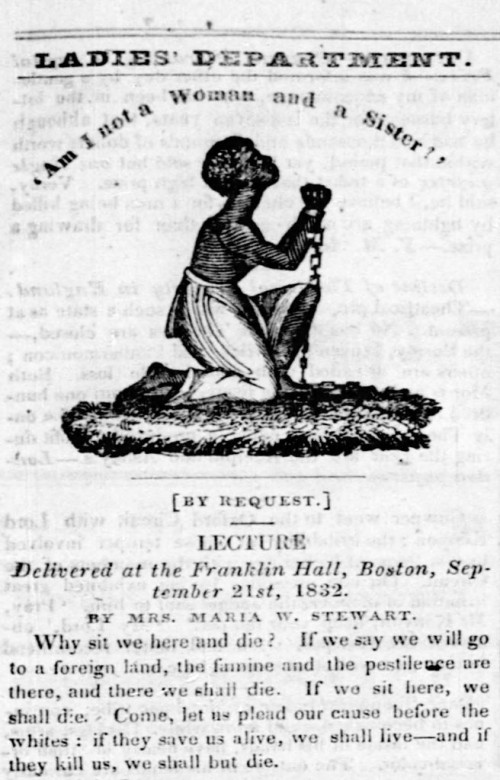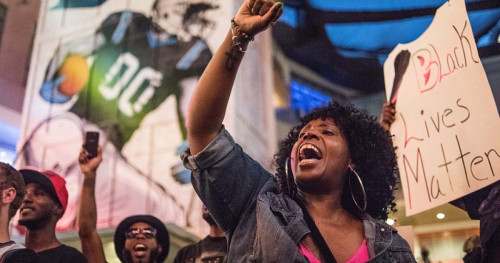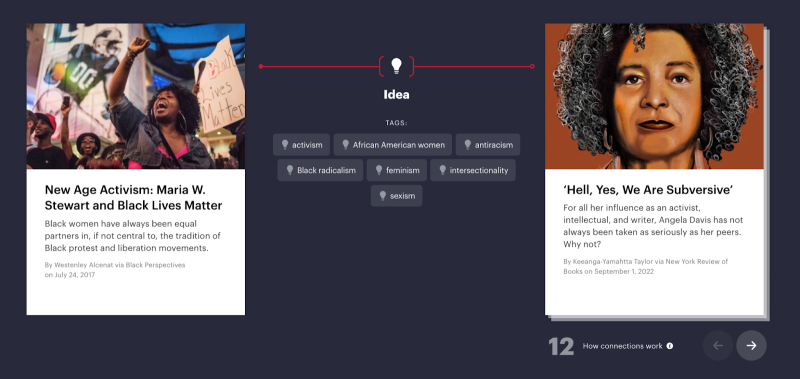This work by New American History is licensed under a Attribution-NonCommercial-ShareAlike 4.0 (CC BY-NC-SA 4.0) International License. Permissions beyond the scope of this license may be available at newamericanhistory.org.
American Visions: An Address at the African Masonic Hall
View Student Version
Standards
C3 Framework:D2.Civ.1.6-8. Distinguish the powers and responsibilities of citizens, political parties, interest groups, and the media in a variety of governmental and nongovernmental contexts.D2.Civ.2.6-8. Explain specific roles played by citizens (such as voters, jurors, taxpayers, members of the armed forces, petitioners, protesters, and office-holders).D2.Civ.7.6-8. Apply civic virtues and democratic principles in school and community settings.D2.Civ.9.6-8. Compare deliberative processes used by a wide variety of groups in various settings.D2.Civ.10.6-8. Explain the relevance of personal interests and perspectives, civic virtues, and democratic principles when people address issues and problems in government and civil society.D2.Civ.13.6-8. Analyze the purposes, implementation, and consequences of public policies in multiple settings.D2.Civ.14.6-8. Compare historical and contemporary means of changing societies, and promoting the common good.D2.Eco.1.6-8. Explain how economic decisions affect the well-being of individuals, businesses, and society.D2.His.1.6-8. Analyze connections among events and developments in broader historical contexts.D2.His.3.6-8. Use questions generated about individuals and groups to analyze why they, and the developments they shaped, are seen as historically significant.D2.His.4.6-8. Analyze multiple factors that influenced the perspectives of people during different historical eras.D2.His.5.6-8. Explain how and why perspectives of people have changed over time.D2.His.6.6-8. Analyze how people’s perspectives influenced what information is available in the historical sources they created.
National Council for Social Studies:Theme: Time, Continuity, ChangeTheme: Culture
National Geography Standards: Standard 4. The physical and human characteristics of places. Standard 6. How culture and experience influence people’s perceptions of places and regions.
EAD Framework:DESIGN CHALLENGE: America’s Plural Yet Shared Story; Civic Honesty, Reflective Patriotism
THEME: Civic ParticipationKEY CONCEPTS:Analyze leadership through past and present examples of change-makers.Analyze strategies and examples of civic participation, including instances of participation by those without full political rights.Engage as active community members and examine the tensions between personal interests and civic responsibilities.Build civic friendship through informed civil dialogue and productive disagreement.Analyze the past and present role of the media in shaping civic participation, including the importance of using credible sources.
RELATED DRIVING QUESTIONS:HSGQ1.3D: What civic roles have been available to those without full political rights?HSGQ1.3E: How have people without full political rights helped to shape the kinds of women and men who have been leaders in the United States?
THEME: We The PeopleKEY CONCEPTSExplore what it means to say that “the people” rule in a constitutional democracyCultivate understanding of personal values, principles, commitments, and community responsibilitiesExplore the challenges and opportunities of pluralism, diversity, and unity within the U.S. and abroadExamine the values, civic virtues, principles, and role of the people in creating good governance at various levelsAnalyze the impact of enslavement, Indigenous removal, immigration, and other hard histories on definitions of and pathways to citizenshipExplore the causes and consequences of different groups’ marginalization from participation in the polityEvaluate the extent to which marginalized groups have won incorporation into “the people” and advanced the shared values and principles of the U.S.
RELATED DRIVING QUESTIONS:HDQ3.3B: How did the institution of enslavement and practices of Indigenous removal and even extermination affect national unity in the U.S., and to what extent have we addressed their impact over time?HSGQ3.3G: How have the many dimensions of diversity pertained to the challenges and opportunities involved in forging one people out of many? (Dimensions of diversity that might be considered include race, ethnicity, gender and sexual identity, religion and spiritual experience, political viewpoint, socioeconomic status, immigration status, geographic origins and language, disability, family structure, and family participation in the military.)
Teacher Tip: Think about what students should be able to KNOW, UNDERSTAND and DO at the conclusion of this learning experience. A brief exit pass or other formative assessment may be used to assess student understandings. Setting specific learning targets for the appropriate grade level and content area will increase student success.
Suggested Grade Levels: middle school; high school
Suggested Timeframe: Two 45-minute periods.
Suggested Materials: Internet access via laptop, tablet, or mobile device, primary source “An Address at the African Masonic Hall” by Maria W. Stewart.
Key Vocabulary
Abolitionist: a person who advocated or supported ending the institution of slavery in the U.S (before and during the American Civil War)
Abominations: a thing that causes disgust or hatred
Abhorrent: something disgusting or repugnant
Alleviate: to make better or improve
Annals: a record of events year by year
Appellation: a name or title
Blest: blessed; being fortunate or lucky
Bondage: the state of being enslaved
Brethren: brothers/sisters, fellow Christians or members of a religious order
Commiseration: sympathy and sorrow for the misfortunes of others
Confine: keep or restrict someone or something within certain limits
Contend: assert something as a position in an argument
Dastard: a dishonorable, evil, or despicable person
Defiance: open resistance; bold disobedience
Deprivation: denying something that is considered a necessity
Deride: express contempt or ridicule; disrespect
Despair: the complete loss or absence of hope
Distinguished: successful; authoritative
Eminence: fame or recognized superiority
Enlightened: having learned or showing a rational, modern, and well-informed outlook
Figurative language: language that uses words or expressions with a meaning that is different from the literal interpretation; used to create a more vivid or imaginative effect, often by comparing things, exaggerating, or using non-literal meanings to convey a deeper message
“Flocked thither”: “to have come here”
Flourishing: developing rapidly; thriving
“Holy indignation”: refers to the concept of rejecting or dismissing anger that is perceived as righteous, often stemming from a deep-seated sense of injustice or moral outrage
Hypocrisy: claiming to have moral standards or beliefs to which one's own behavior does not conform; pretense
Illustrious: well-known and respected
Impertinence: lack of respect, rudeness
Insipid: bland or weak
Laborious: requiring a great deal of effort, time, or attention, often to the point of being tiresome or difficult
Laudable: an action that deserves praise
Lisp: a speech defect in which s is pronounced like th in thick and z is pronounced like th in this
Literary devices: stylistic choices writers or speakers make to achieve specific effects; such devices can be used in any form of writing, from poetry and novels to speeches and even everyday conversation
Negligence: failure to take proper care in doing something
Prejudice: preconceived opinion that is not based on reason or actual experience
Primary Source: an original document, object, or account created during the time period being studied, offering first-hand information or direct evidence of an event, person, or idea
Prodigality: lack of care; the act of being wasteful
Prudence: cautiousness; being careful
“Racially integrated”: the process of ending racial segregation and allowing people of different races to interact, live, and participate together in society
References: for this lesson, suggestions made in the Address that refer to other people, places, or events.
Reproach: address (someone) in such a way as to express disapproval or disappointment
Requisite: made necessary by particular circumstances or regulations
“Sable race”: refers to people of African descent, using "sable" as a descriptive term for their dark skin color
Self-righteous: an unfounded feeling that one is totally correct or morally superior; thinking oneself better than others
Servitude: the state of being enslaved
Spurn: to reject with contempt, to treat someone as worthless
Transgressions: an act that goes against a law, rule, or code of conduct; an offense
Wit: intelligence
Woes: great sorrow, sadness, or distress
Wretch: an unfortunate and unhappy person
“Yoke of oppression”: metaphorically refers to a state of being burdened or enslaved by an unjust power or authority
Historical References:
African Masonic Hall: The first Masonic lodge established for African Americans in the United States, founded in 1775 by Prince Hall and 14 other free Black Bostonians.
Bulls of Bashan: These symbolize powerful and oppressive enemies surrounding a biblical writer, drawing on the biblical region of Bashan, known for its rich pastures and strong cattle, to represent strength and abundance.
Colonization Society: The American Colonization Society (ACS), founded in 1816, aimed to resettle free African Americans in Africa, believing they would have more freedom and opportunity there than in the United States, and it established the colony of Liberia.
King Solomon: King Solomon (mentioned in the Christian Bible) is most famously known for his wisdom, the construction of the Temple in Jerusalem, and his role as the third king of the United Kingdom of Israel.
Liberia: In 1822, the ACS established the colony of Liberia on the West Coast of Africa, which eventually became the nation of Liberia, as a settlement for free blacks.
Moses: In the Hebrew Bible/Christian Old Testament, Moses is portrayed as a prophet who receives the Ten Commandments from God. Earlier in his story, he is responsible for leading the Israelites out of slavery and parting the Red Sea to let them escape from the Egyptians.
Pharaoh king of Egypt: The Bible doesn't name the specific pharaoh who released the Israelites, but scholars often point to Ramses II as a likely candidate, or at least a pharaoh in the 13th century BCE, during the time of the Exodus.
“Under the command of Jackson”: Stewart is referring to Andrew Jackson, the 7th President of the United States, who was a prominent figure in the early 19th century and a symbol of the expansion of white male power and the oppression of marginalized groups.
Read for Understanding
Teacher Tips:
New American History Learning Resources may be adapted to a variety of educational settings, including remote learning environments, face-to-face instruction, and blended learning.
If you are teaching remotely, consider using videoconferencing to provide opportunities for students to work in pairs or small groups. Digital tools such as Google Docs or Google Slides may also be used for collaboration. Rewordify helps make a complex text more accessible for those reading at a lower Lexile level while still providing a greater depth of knowledge.
Teachers of Multilingual Learners may find that using sentence frames can help ELLs by providing a structured framework that can support them when expressing their ideas in complete sentences, whether they are speaking or writing. It serves as a scaffold for ELLs who struggle with grammar and/or vocabulary while promoting the use of academic language. Similarly, providing vocabulary definitions within a differentiated copy of the article, thereby bridging the gap between past and present language, can help students better comprehend the archaic or old-fashioned words used by the author as they read through the text, so they may better engage with the material.
Exit tickets and graphic organizers allow students to reflect on their learning and enhance their communication skills. The Engage, Explore, and Explain sections of this learning resource include graphic organizers/exit tickets that use Give One/Get One, Sketchnotes, The Three Reads Protocol, and S-I-T Strategy for further engagement. Templates are linked within the lesson for you to modify, for students to copy, or to print paper copies for your students as needed.
These Learning Resources follow a variation of the 5Es instructional model, and each section may be taught as a separate learning experience or as part of a sequence of learning experiences. We provide each of our Learning Resources in multiple formats, including web-based and as an editable Google Doc for educators to teach and adapt selected learning experiences as they best suit the needs of your students and local curriculum. You may also wish to embed or remix them into a playlist for students working remotely or independently.
Read for Understanding (for students)
Maria W. Stewart was an African American abolitionist, writer, and women's rights advocate in the 19th century. She was one of the first American women to speak publicly against slavery and for the rights of African Americans. She was influential in speaking out against racial and gender inequalities.
Stewart gained attention for her powerful speeches. She spoke to mixed-race audiences, which was rare for women at the time. Her speaking engagements were often in churches and later at places like the African Masonic Hall in Boston, where, in 1833, she delivered this particular speech. Within this speech, she outlined her vision for racial equality, the abolition of slavery, and the importance of Black education and self-improvement.
Engage:
How can an image (with few words) persuade us to listen and take action?
American Visions: The United States 1492 to the Present by historian Dr. Edward L. Ayers is a comprehensive exploration of American history, including various people and events often left out of traditional textbooks. You can explore the American Visions website and select “Original Sources” to view and read the words and images from this time period in their original form.
- Are any of these names or events familiar to you?
- Are there any you might want to know more about?
Search for Maria W. Stewart under “Original Sources.” You will find her entry under Chapter 3: Rebellions 1827 - 1836.
As you observe this image of the primary source document closely, take notes:
- What do you notice from this image?
- What ideas come to mind?
- What does it make you think about?
Sentence Frames:
- I notice that _____________________________________________________.
- I can observe that ________________________________________________.
- I see ____________________________________________________________.
- This reminds me of _______________________________________________.
- This makes me think about _______________________________________.
Then use the Give One/Get One protocol to exchange ideas with a classmate (or two) and record your answers below using the graphic organizer provided.
Your teacher may ask you to record your answers on an exit ticket.
Explore:
How do multiple readings of a text deepen our understanding of a speaker’s message and help us comprehend the urgency behind their words?
After analyzing the image printed along with Maria W. Stewart’s speech in The Liberator, read her “Address at the African Masonic Hall.”
You will use the Three Reads Protocol while reading this text; it involves multiple readings (and re-readings) of the text to ensure a clear understanding of the message, a close analysis of the speaker’s choice of words and phrases, and the making of connections between historical events and a call to action. You may use this Three Reads graphic organizer to make a digital copy or use a printed copy provided by your teacher.
First read - Comprehension: Read the speech with a partner or in a small group. Read the speech all the way through, stopping to clarify vocabulary and big ideas. After this first read, discuss the central idea or big ideas within Maria W. Stewart’s speech.
Questions to consider:
- What is this speech mostly about?
- What are some of the “big ideas” the speaker brings up?
- What do you think the speaker’s message to her audience is?
Second Read - Analysis: Read the speech a second time, either independently or with a partner, and highlight/underline parts of the speech that stand out to you.
Questions to consider:
- What words and/or phrases are you choosing to highlight/underline?
- What causes these words/phrases to stand out to you?
- Are they surprising? Shocking?
- Do you agree or disagree with them?
- Are there any literary devices, figurative language or references that the speaker makes that could appeal to her audience?
- Are these words/phrases important to conveying the speaker’s message to her audience? Why or why not?
Third Read - Connecting to Context: Read through the speech a third time, and consider the context of the historical time period. You may reference a timeline to get a sense of the various events happening around the U.S. during the 1830s, and discuss your ideas within a small group as directed by your teacher.
Questions to consider:
- What interesting events were happening around the U.S. during the time period?
- What connections can you make between these events and Maria W. Stewart’s speech?
- Considering these events, what do you think made this speech such a compelling call to action for her audience?
Your teacher may ask you to record your answers on an exit ticket.
Explain:
What makes a speech compelling and what moves its audience to take action?
With a partner or within a small group, spend some time discussing your Three Reads Protocol notes and any annotations you may have made on your copy of Maria W. Stewart’s “Address at the African Masonic Hall.” You may read along on the digital copy or use a printed copy if provided by your teacher.
Take notes using the S-I-T strategy and this graphic organizer of the people, places, and events you are most interested in exploring.
Consider the question:
- What makes Maria W. Stewart’s “Address at the African Masonic Hall” compelling? Explain.
Your teacher may provide a paper copy, or you may make a copy of the Google Docs version using the link above to record your responses.
Your teacher may ask you to record your answers on an exit ticket.
Elaborate:
How do literary devices and figurative language convey a message or call to action to an audience?
Choose a section of “An Address at the African Masonic Hall” to discuss further. (You may select any of the sections you have already highlighted or underlined.).
- What does it say?
- What literary devices or figurative language does the speaker use to get her audience’s attention?
- What is the message she is trying to convey?
- Why is this significant?
- How does this motivate the audience to take action?
Model/Example:
“We have pursued the shadow, they have obtained the substance;
We have performed the labor, they have received the profits;
We have planted the vines, they have eaten the fruits of them.”
This passage contains several literary devices and examples of figurative language:
Antithesis: The structure of the sentences presents two opposing ideas, creating contrast:
- "We have... they have..." contrasts the efforts of "we" with the rewards received by "they."
- The opposition between “shadow” and “substance,” “labor” and “profits,” and “planted” and “eaten” emphasizes the unfairness of the situation.
Parallelism:
- The repeated sentence structure (“We have... they have...”) creates rhythm and reinforces the contrast. The repetition of verbs like "have" creates a sense of balance between the two subjects.
Metaphor:
- “Shadow” and “substance” are metaphors. The “shadow” represents something insubstantial or elusive, while the “substance” represents something real or meaningful. This suggests that "we" have pursued something empty or intangible, while "they" have obtained something valuable or concrete.
- "Planted the vines" metaphorically represents labor or effort, and "eaten the fruits" symbolizes reaping the rewards or benefits.
Imagery:
- The mention of "planted the vines" and "eaten the fruits" evokes a vivid picture of agricultural work, bringing to life the idea of hard work and subsequent enjoyment of rewards.
Repetition:
- The repetition of the phrase "We have..." emphasizes the continual effort and labor on the part of the speaker, which contrasts with the rewards "they" have gained without similar effort.
Together, these devices convey a sense of injustice and inequality in the distribution of labor and reward.
Share your interpretation with a partner, and listen to their own ideas and inferences based on one of the images.
Your teacher may ask you to record your answers on an exit ticket.
Extend:
What role do Black women play in the Black protest and liberation movement today?
Throughout history, women have played various pivotal roles, leading the way in the fight for equality and liberation.
Read this Bunk excerpt, “New Are Activism: Maria W. Stewart and Black Lives Matter,”
Select the “View Connections” button to explore more excerpts as connected in Bunk. You may choose different icons as you explore. Note the associated tags that connect each excerpt to another. Explore one or more tags.
Consider the following:
- What role have women played in modern protests and civil rights movements?
- Are there any women in particular that you would like to learn more about?
Explore some of the Bunk connections to help you formulate your answers.
Your teacher may ask you to record your answers on an exit ticket.
Citations:
Ayers, Edward. American Visions – Chapter 3: Rebellions. October 24, 2023. Accessed March 23, 2025. https://storymaps.arcgis.com/collections/684a16d2ddcb44609011f211e21c6596?item=3
Alcenat, Westenley. “New Age Activism: Maria W. Stewart and Black Lives Matter.” Black Perspectives. July 24, 2017. Accessed March 25, 2025. https://www.bunkhistory.org/resources/new-age-activism-maria-w-stewart-and-black-lives-matter
BlackPast. “(1833) Maria W. Stewart, ‘An Address at the African Masonic Hall’.” October 24, 2011. Blackpast.org. Accessed March 23, 2025. https://www.blackpast.org/african-american-history/1833-maria-w-stewart-address-african-masonic-hall/
Facing History and Ourselves. “What is the Give One, Get One Strategy?” February 20, 2015. Accessed March 23, 2025. https://www.facinghistory.org/resource-library/give-one-get-one
Keller, Keeley, “10 Reasons You Should Use Sentence Frames In Your Classroom.” September 9, 2022. TeachingChannel.com. Accessed March 23, 2025. https://www.teachingchannel.com/k12-hub/blog/10-reasons-you-should-use-sentence-frames-in-your-classroom/#:~:text=1)
New Visions for Public Schools. Three Reads Protocol for Social Studies. Accessed March 25, 2025. https://curriculum.newvisions.org/social-studies/resources/resource/instructional-routine-three-reads-protocol/
PBWorks.com. Teaching Reading and Language. “Literary Devices & Terms.” Accessed March 25, 2025. https://teachingreadingandla.pbworks.com/f/Literary+Devices.pdf
“S-I-T: Surprising, Interesting, Troubling.” Facing History & Ourselves. Accessed June 17, 2024. https://www.facinghistory.org/resource-library/s-i-t-surprising-interesting-troubling
The Teacher Toolkit, “Exit Ticket.” Accessed March 23, 2025. https://www.theteachertoolkit.com/index.php/tool/exit-ticket
Thirteen - PBS. Slavery and the Making of America - Time and Place. Accessed March 24, 2025. https://www.thirteen.org/wnet/slavery/timeline/1831.html
View this Learning Resource as a Google Doc


